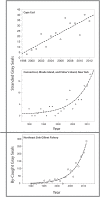Trends in Stranding and By-Catch Rates of Gray and Harbor Seals along the Northeastern Coast of the United States: Evidence of Divergence in the Abundance of Two Sympatric Phocid Species?
- PMID: 26200461
- PMCID: PMC4511798
- DOI: 10.1371/journal.pone.0131660
Trends in Stranding and By-Catch Rates of Gray and Harbor Seals along the Northeastern Coast of the United States: Evidence of Divergence in the Abundance of Two Sympatric Phocid Species?
Abstract
Harbor seals and gray seals are sympatric phocid pinnipeds found in coastal waters of the temperate and sub-Arctic North Atlantic. In the Northwest Atlantic, both species were depleted through a combination of subsistence hunts and government supported bounties, and are now re-occupying substantial portions of their original ranges. While both species appear to have recovered during the past 2 decades, our understanding of their population dynamics in US waters is incomplete. Here we describe trends in stranding and bycatch rates of harbor and gray seals in the North East United States (NEUS) over the past 16 years through an exploratory curve-fitting exercise and structural break-point analysis. Variability in gray seal strandings in Southern New England and bycatch in the Northeast Sink Gillnet Fishery were best described by fitting positive exponential and linear models, and exhibited rates of increase as high as 22%. In contrast, neither linear nor exponential models fit the oscillation of harbor seal strandings and bycatch over the study period. However, a breakpoint Chow test revealed that harbor seal strandings in the Cape Cod, Massachusetts region and harbor seal bycatch in the Northeast Sink Gillnet Fishery increased in the 1990s and then started declining in the early to mid-2000s. Our analysis indicates that ongoing variation in natural and anthropogenic mortality rates of harbor and gray seals in the NEUS is not synchronous, and likely represents diverging trends in abundance of these species as they assume new roles in the marine ecosystems of the region.
Conflict of interest statement
Figures


Similar articles
-
Epizootiology of morbillivirus infection in North American harbor seals (Phoca vitulina) and gray seals (Halichoerus grypus).J Wildl Dis. 1995 Oct;31(4):491-501. doi: 10.7589/0090-3558-31.4.491. J Wildl Dis. 1995. PMID: 8592380
-
The northern shrimp (Pandalus borealis) offshore fishery in the Northeast Atlantic.Adv Mar Biol. 2007;52:147-266. doi: 10.1016/S0065-2881(06)52002-4. Adv Mar Biol. 2007. PMID: 17298891 Review.
-
Opportunistic detection of anthropogenic micro debris in harbor seal (Phoca vitulina vitulina) and gray seal (Halichoerus grypus atlantica) fecal samples from haul-outs in southeastern Massachusetts, USA.Mar Pollut Bull. 2019 Aug;145:390-395. doi: 10.1016/j.marpolbul.2019.06.020. Epub 2019 Jun 21. Mar Pollut Bull. 2019. PMID: 31590801
-
Long-Term Seasonal and Interannual Patterns of Marine Mammal Strandings in Subtropical Western South Atlantic.PLoS One. 2016 Jan 27;11(1):e0146339. doi: 10.1371/journal.pone.0146339. eCollection 2016. PLoS One. 2016. PMID: 26814667 Free PMC article.
-
New Zealand's cetaceans and pinnipeds.N Z Vet J. 1981 Nov;29(11):192-3. doi: 10.1080/00480169.1981.34845. N Z Vet J. 1981. PMID: 16030799 Review.
Cited by
-
Molecular Mechanisms Underlying Response to Influenza in Grey Seals (Halichoerus grypus), a Potential Wild Reservoir.Mol Ecol. 2025 Aug;34(15):e70012. doi: 10.1111/mec.70012. Epub 2025 Jul 4. Mol Ecol. 2025. PMID: 40613337 Free PMC article.
-
The global extent and severity of operational interactions between conflicting pinnipeds and fisheries.Nat Commun. 2024 Aug 28;15(1):7449. doi: 10.1038/s41467-024-51298-6. Nat Commun. 2024. PMID: 39198436 Free PMC article.
-
Google Haul Out: Earth Observation Imagery and Digital Aerial Surveys in Coastal Wildlife Management and Abundance Estimation.Bioscience. 2017 Aug 1;67(8):760-768. doi: 10.1093/biosci/bix059. Epub 2017 Jun 14. Bioscience. 2017. PMID: 29599542 Free PMC article.
-
Automated detection and enumeration of marine wildlife using unmanned aircraft systems (UAS) and thermal imagery.Sci Rep. 2017 Mar 24;7:45127. doi: 10.1038/srep45127. Sci Rep. 2017. PMID: 28338047 Free PMC article.
-
Prevalence of influenza A virus in live-captured North Atlantic gray seals: a possible wild reservoir.Emerg Microbes Infect. 2016 Aug 3;5(8):e81. doi: 10.1038/emi.2016.77. Emerg Microbes Infect. 2016. PMID: 27485496 Free PMC article.
References
-
- Mowat F. Sea of Slaughter. Mechanicsburg, PA: Stackpole Books; 2004.
-
- Boehme L, Thompson D, Fedak M, Bowen WD, Hammill MO, Stenson GB. How Many Seals Were There? The Global Shelf Loss during the Last Glacial Maximum and Its Effect on the Size and Distribution of Grey Seal Populations. Bograd SJ, editor. PLoS One. Public Library of Science; 2012. December 26;7(12):e53000 10.1371/journal.pone.0053000 - DOI - PMC - PubMed
-
- Pannozzo L. The Devil and the Deep Blue Sea: An Investigation into the Scapegoating of Canada's Grey Seal. Black Point, NS: Fernwood Publishing; 2013.
-
- Wood SA, Frasier TR, McLeod BA, Gilbert JR, White BN, Bowen WD, et al. The genetics of recolonization: an analysis of the stock structure of grey seals (Halichoerus grypus) in the northwest Atlantic. Can J Zool. 2011. June;89(6):490–7.
-
- Lelli B, Harris DE, Aboueissa A-M. Seal Bounties in Maine and Massachusetts, 1888 to 1962. Northeast Nat. 2009. June 30;16(2):239–54.
MeSH terms
LinkOut - more resources
Full Text Sources
Other Literature Sources
Miscellaneous

